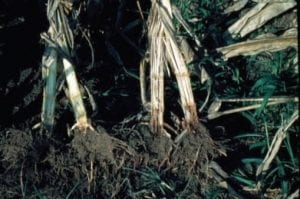Arvydas (Arv) Grybauskas, Extension Plant Pathologist, University of Maryland; arvydas@umd.edu
Corn harvest will begin earlier this season due to the high average temperatures increasing the speed with which growing degree-days (GDD) have accumulated. Typically in seasons characterized by high temperatures and droughty conditions there is an increase in stalk rots and certain ear rots. Most notably two fungal ear rots that can produce toxins in the grain, Aspergillus and Fusarium ear rot, are favored by these conditions. The more dangerous of the two is Aspergillus. Aspergillus infected kernels can contain the carcinogenic toxins known as aflatoxins.
Aspergillus is a fungus that is highly tolerant of high temperatures. Because of its high temperature tolerance it is the most prevalent ear-infecting fungus during hot dry conditions. The fungus survives is soil and crop debris and is spread to silks by wind and insects. The use of certain types of BT corn have helped reduce the incidence of Aspergillus infection by reducing the insect-associated infections but direct infections are still possible. Stressed corn appears to be more susceptible to infection. Typically only a few kernels near the tip are infected by Aspergillus, but tolerance levels for aflatoxin are in parts per billion (e.g. 20 ppb for human consumption). A blacklight is commonly employed as a quick preliminary test for aflatoxin contamination. A sample of cracked or coarsely ground kernels is illuminated with a blacklight and viewed for a yellow-green fluorescence. It is important to know that the fluorescing material is not aflatoxin itself but often is an indicator of (correlated with) aflatoxin. Other material will fluoresce under blacklight like corn glumes (a.k.a. beeswings), certain weed seeds, and uninfected kernel tips, so that false positives are possible. Since the advisory limits are at ppb levels false negatives are also possible with the blacklight test. There are commercially available rapid test kits that provide better and in many cases quantitative detection, as well as commercial labs that will test for toxins.
Similarly, Fusarium ear and kernel rot is favored by high temperatures and droughty conditions especially when they occur near flowering. There are several species of Fusarium that are involved but generally are different from the primary species that cause scab in wheat. Fusarium ear and kernel rot is important because of a production of a class of toxins known as Fumonisins. Fumonisins are known to cause equine leukoencephalomalacia, “blind staggers” in horses and pulmonary edema in swine, and have been linked to human cancers in other parts of the world. Different tests are required to detect Fumonisins.
Stalk rots caused by fungi leading to premature lodging are also generally favored by stressful growing seasons. In general any stress on the corn plant can lead to insufficient capacity of the plant to provide photosynthate to the developing ear. When the capacity is exceeded the plant mobilizes stored carbohydrates from the stalks to fill the demand. This leads to premature senescence of stalk tissue and predisposes the plant to colonization by any number of opportunistic stalk rotting fungi.
Regardless of the stalk rot or ear rot, there are a few things that can be done to minimize losses and improve the harvestablity. First, harvest the corn at high grain moisture (25 to 27%), and make sure the combine is adjusted properly to minimize cracking. Harvesting as early as practical reduces the time that the damaging fungi have at colonizing the tissue. This reduces lodging due to stalk rots, kernel infection and toxin development. Cracked kernels are more susceptible to post-harvest colonization and toxin development. You can also use simple pre-harvest stalk testing to determine which fields are at greater risk for lodging to schedule harvest accordingly. You can pinch stalk internodes to determine a percentage that are soft and likely to lodge if left in the field, or you can use the push test. The push test is simply pushing corn stalks at arms length and determining the percentage that break. In both cases the greater the number of plants and sites scouted the better the information. A rule of thumb I like is 10 stalks in 10 sites for every 10 acres. It is also important to note that fungicides used near tassel will not have a direct effect on stalk rotting. If there was a foliar disease then fungicides reduce the stress associated with the foliar disease and this indirectly reduces stalk rotting. There is no fungicide residue available by the time stalks are predisposed to stalk rotting fungi to directly affect the colonization by these fungal organisms.
Secondly, to reduce the damage from ear rots and in particular to keep toxin development to a minimum, after harvesting corn at high moisture with careful attention to reduce cracking, dry the corn as soon as possible (within a day or two) to 15.5% moisture or lower. The ear rotting fungi continue to grow in high moisture corn in the bin. Controlling moisture and temperature of harvested corn is the most cost-effective method of preventing spoilage.


